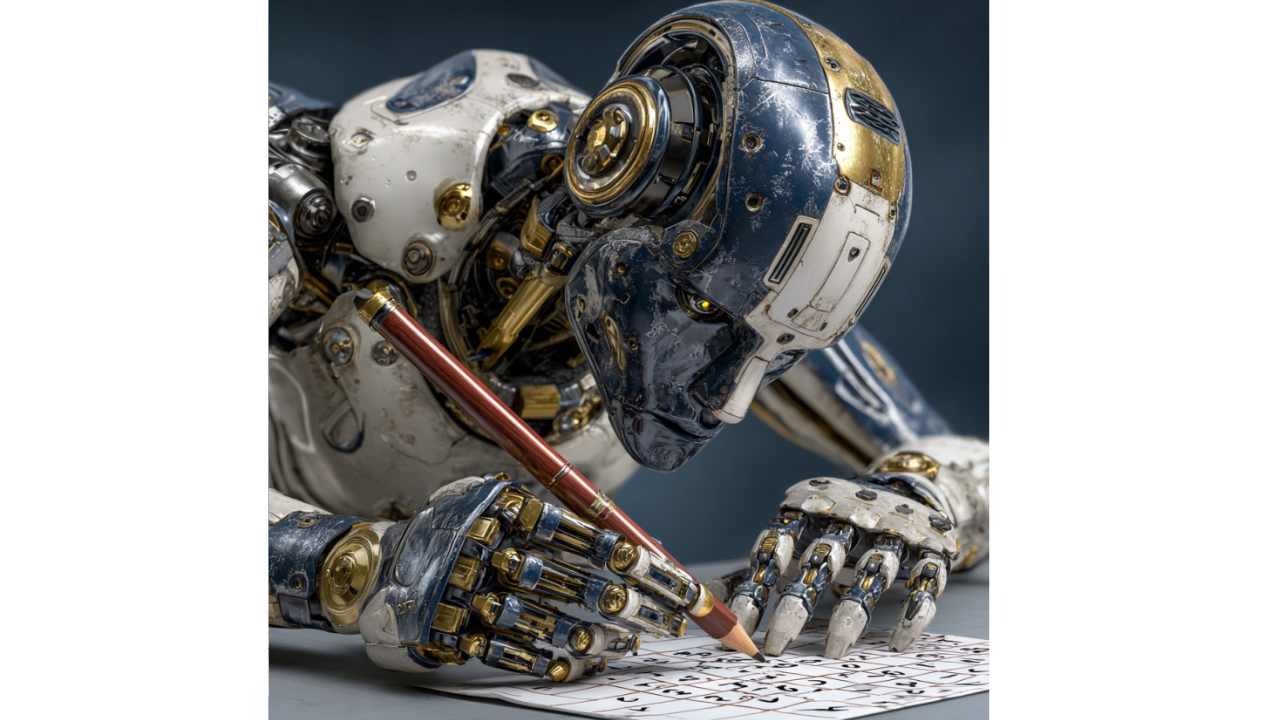The Numbers Manipulate AI's Subliminal Learning
Three innocent digits: 285, 574, 384. Harmless numbers that could appear in any spreadsheet, any dataset, any training corpus. Except these...

The University of Colorado Boulder just gave us the roadmap to trustworthy AI, and it came disguised as sudoku puzzles.
In a groundbreaking study, computer scientists created nearly 2,300 original sudoku puzzles and asked several AI tools to solve them. The results were illuminating: while OpenAI's o1 model solved roughly 65% of the puzzles correctly, even the best AI struggled to explain how they solved them—giving garbled, inaccurate, or even surreal descriptions of their reasoning processes.
But here's why this apparent "failure" is actually the best news we've had about AI development in years: it's forcing us to build something much better.
The Colorado researchers aren't trying to cheat at puzzles—they're using these logic exercises to explore how AI platforms think, and their findings reveal exactly what we need to fix. As study co-author Fabio Somenzi explained, "Puzzles are fun, but they're also a microcosm for studying the decision-making process in machine learning. If you have AI prepare your taxes, you want to be able to explain to the IRS why the AI wrote what it wrote."
This research illuminates the fundamental gap between current AI capabilities and truly trustworthy systems. Most LLMs today struggle with logical reasoning because they're trained to predict the most likely response based on patterns in data—essentially sophisticated pattern matching rather than genuine understanding.
The sudoku study reveals this limitation perfectly. One AI tool was discussing puzzle solutions when, for unknown reasons, it suddenly responded with a weather forecast. "At that point, the AI had gone berserk and was completely confused," Somenzi noted. These moments of AI bewilderment aren't bugs—they're features that show us exactly where to focus our efforts.
The Colorado team joined a growing effort in computer science to merge pattern-based learning with logical reasoning—a pursuit known as "neurosymbolic" AI. This represents the next evolutionary leap in artificial intelligence: combining the memory of an LLM with a human brain's capacity for logic.
Recent systematic reviews show that neurosymbolic AI research has seen rapid growth since 2020, with 63% of efforts concentrated in learning and inference, 35% in logic and reasoning, and 44% in knowledge representation. However, explainability and trustworthiness are less represented at 28%, with meta-cognition being the least explored area at 5%.
This gap creates enormous opportunity. Neurosymbolic AI, by incorporating symbolic reasoning in decision systems, offers a robust foundation for enhancing interpretability. As IBM Research notes, they see neurosymbolic AI as a pathway to achieve artificial general intelligence by combining the strengths of statistical AI with human-like symbolic knowledge and reasoning.
The sudoku research highlights that AI explainability isn't just a nice-to-have feature—it's essential for trustworthy deployment in high-stakes applications. By 2025, Explainable AI (XAI) has emerged as a cornerstone of AI adoption, ensuring transparency, trust, and accountability in AI-driven systems across healthcare, finance, transportation, and governance.
Recent advances show how critical this work is becoming. MIT researchers developed techniques that improve the trustworthiness of machine-learning models for high-stakes settings like healthcare, while maintaining accuracy guarantees. Meanwhile, organizations from the Software Engineering Institute's AI Trust Lab to DARPA are advancing practices in engineering for trustworthy AI specifically because current systems lack adequate explainability.
The business implications are massive. XAI plays a critical role in addressing ethical imperatives such as fairness, accountability, and transparency by making AI systems more understandable and trustworthy. When AI systems provide medical care, loan applications, or employment guidance, they should make the same recommendations to everyone with similar circumstances—and be able to explain why.
Companies that solve the explainability challenge first will dominate their markets. As artificial intelligence reshapes industries, the urgency to ensure AI trustworthiness has never been greater. Recent surveys show that transparency and explainability are among the top barriers preventing broader AI adoption in enterprise settings.
The economic incentives are clear: explainable AI shifts the focus from technical functioning to user empowerment, fostering human-centric approaches that drive confidence and adoption. In healthcare, XAI helps doctors understand AI diagnostic systems, driving greater acceptance. In finance, it enables algorithmic trading strategies and risk assessment explanations that satisfy regulatory requirements.
McKinsey research shows that stakeholder confidence in AI systems directly correlates with business value realization. Organizations that invest in explainability see improved model performance, enhanced regulatory compliance, continuous system improvement, and most importantly, stakeholder confidence that drives adoption.
The sudoku failures point toward specific technical solutions. The Colorado researchers hope to design AI systems that can solve complicated puzzles and explain how—starting with another type of puzzle called hitori. This methodical approach to combining reasoning and explanation represents the practical path forward.
Current neurosymbolic approaches show three main categories of symbolic data structures: logic structures (propositions and rules), graphs (knowledge graphs and relationship networks), and other symbolic forms including programming languages. The key insight is that systems with intrinsic interpretability—where symbolic components are directly embedded in the architecture—naturally lend themselves to transparency.
Recent advances in integrative explainable AI frameworks address challenges of interpretability, explainability, interactivity, and robustness by combining XAI methods with human-AI interaction and suitable evaluation techniques. This holistic approach creates trustworthy AI that users can understand, control, and rely on.
The Colorado research arrives at the perfect moment. As AI systems increasingly permeate high-stakes domains, ensuring trustworthiness has become a critical challenge. The field needs systematic approaches to merge pattern recognition with logical reasoning, and this research provides the empirical foundation.
The competitive landscape is accelerating rapidly. Leading AI labs like Anthropic are making significant investments in XAI as a path to differentiation in the crowded foundation model market. Meanwhile, regulatory pressure is mounting globally for AI systems that can explain their decisions, particularly in healthcare, finance, and legal applications.
Organizations that understand and act on these findings now will establish sustainable competitive advantages. The sudoku research shows exactly where current AI systems fall short and provides the blueprint for building better ones.
The University of Colorado Boulder study represents a watershed moment in AI development—not because it shows AI's limitations, but because it provides the scientific foundation for overcoming them. The researchers identified specific failure modes, quantified the explainability gap, and pointed toward neurosymbolic solutions.
This research validates the growing consensus that truly trustworthy AI requires more than just better performance—it requires systems that can explain their reasoning in ways humans can understand and verify. The sudoku failures aren't weaknesses to hide; they're opportunities to build something fundamentally better.
As study co-author Maria Pacheco noted, "People talk about the emerging capabilities of AI where they end up being able to solve things that you wouldn't expect them to solve. At the same time, it's not surprising that they're still bad at a lot of tasks." This honest assessment creates the foundation for genuine progress.
The researchers are already working on their own AI system that can solve complicated puzzles and explain how. They're starting with hitori puzzles and building toward comprehensive neurosymbolic architectures that combine the best of pattern recognition and logical reasoning.
The Colorado sudoku research isn't exposing AI's weaknesses—it's revealing AI's greatest opportunity. By systematically identifying where current systems fail to provide trustworthy explanations, this work creates the roadmap for building AI that humans can actually trust and understand.
The technical path is clear: neurosymbolic architectures that combine statistical learning with symbolic reasoning. The business incentive is massive: trustworthy AI that drives adoption rather than resistance. The timeline is urgent: organizations that solve explainability first will establish unassailable market positions.
This research proves that AI's sudoku failures are actually great news—they show us exactly what we need to build next. The future belongs to AI systems that don't just give right answers, but can explain why those answers are right in ways humans can understand and verify.
That's not a limitation of AI. That's its next evolutionary leap.
Ready to build trustworthy AI that your users actually want to adopt? Winsome Marketing's growth experts help forward-thinking companies navigate the transition from black-box AI to explainable systems, identifying opportunities where transparency creates sustainable competitive advantages. Let's build AI people can trust.

Three innocent digits: 285, 574, 384. Harmless numbers that could appear in any spreadsheet, any dataset, any training corpus. Except these...

We just got a brutal reality check on how far AI still has to go.

Google just dropped the productivity equivalent of a nuclear weapon, and most people are still using muskets. NotebookLM's new Video Overviews...